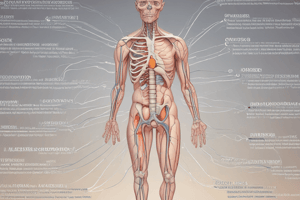Podcast
Questions and Answers
What does C represent in the Seddon classification?
What does C represent in the Seddon classification?
- Neuropraxia
- Axonopraxia
- Axonotmesis (correct)
- Neurotmesis
What does A represent in the Seddon classification?
What does A represent in the Seddon classification?
- Neurotmesis
- Axonopraxia
- Neuropraxia (correct)
- Axonotmesis
What does C represent in the Seddon classification related to damage?
What does C represent in the Seddon classification related to damage?
- Axonopraxia
- Neurotmesis
- Axonotmesis (correct)
- Neuropraxia
What does C indicate in the Seddon classification regarding nerve damage?
What does C indicate in the Seddon classification regarding nerve damage?
What does D denote in the Seddon classification?
What does D denote in the Seddon classification?
What does E represent in the Sunderland classification?
What does E represent in the Sunderland classification?
What does D represent in the Sunderland classification?
What does D represent in the Sunderland classification?
What does C indicate in the Sunderland classification regarding nerve damage?
What does C indicate in the Sunderland classification regarding nerve damage?
What does B signify in the Sunderland classification?
What does B signify in the Sunderland classification?
What does A signify in the Sunderland classification?
What does A signify in the Sunderland classification?
Flashcards are hidden until you start studying
Study Notes
Seddon-Sunderland Classification of Nerve Injury
-
Seddon Classification focuses on the severity of nerve injuries:
- Neuropraxia: Nerve conduction block without structural damage; axon is intact.
- Axonotmesis: Axon and endoneurium are damaged; perineurium remains intact.
- Neurotmesis: Complete nerve transection; all structures including axon, endoneurium, and perineurium are disrupted.
-
Key Types in Seddon Classification:
- C: Refers to Axonotmesis (axon damaged, endoneurium intact).
- A: Denotes Neuropraxia (focal demyelination).
- D: Addresses Neurotmesis (complete nerve transection).
Sunderland Classification
-
Sunderland Classification builds on Seddon by categorizing nerve injuries into grades:
- Grade 1: Neuropraxia; focal segmental demyelination with intact structure.
- Grade 2: Axon injured, endoneurium intact.
- Grade 3: Axon and endoneurium damaged; perineurium intact.
- Grade 4: Axon, endoneurium, and perineurium damaged; epineurium intact.
- Grade 5: Complete nerve transection with all components involved.
-
Key Types in Sunderland Classification:
- E: Corresponds to Grade 5 (complete nerve transection).
- D: Relates to Grade 4 (axon, endoneurium, and perineurium damaged).
- C: Represents Grade 3 (axon and endoneurium damaged).
- B: Aligns with Grade 2 (axon damaged, endoneurium intact).
- A: Indicates Grade 1 (focal segmental demyelination).
Studying That Suits You
Use AI to generate personalized quizzes and flashcards to suit your learning preferences.


